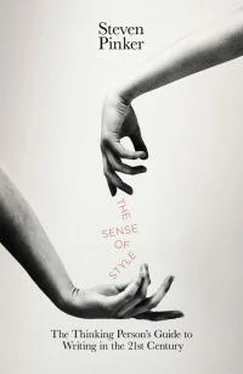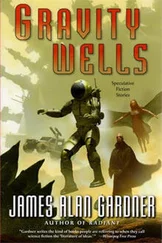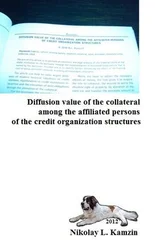Perhaps the best way to remember the dangers of private abbreviation is to recall the joke about a man who walks into a Catskills resort for the first time and sees a group of retired borscht-belt comics telling jokes around a table with their pals. One of them calls out, “Forty-seven!” and the others roar with laughter. Another follows with “A hundred and twelve!” and again the others double over. The newcomer can’t figure out what’s going on, so he asks one of the old-timers to explain. The man says, “These guys have been hanging around together so long they know all the same jokes. So to save time they’ve given them numbers, and all they need to do is call out the number.” The new fellow says, “That’s ingenious! Let me try it.” So he stands up and calls out, “Twenty-one!” There is a stony silence. He tries again: “Seventy-two!” Everyone stares at him, and nobody laughs. He sinks back into his seat and whispers to his informant, “What did I do wrong? Why didn’t anyone laugh?” The man says, “It’s all in how you tell it.”
A failure to realize that my chunks may not be the same as your chunks can explain why we baffle our readers with so much shorthand, jargon, and alphabet soup. But it’s not the only way we baffle them. Sometimes wording is maddeningly opaque without being composed of technical terminology from a private clique. Even among cognitive scientists, “poststimulus event” is not a standard way to refer to a tap on the arm. A financial customer might be reasonably familiar with the world of investments and still have to puzzle over what a company brochure means by “capital changes and rights.” A computer-savvy user trying to maintain his Web site might be mystified by instructions on the maintenance page which refer to “nodes,” “content type,” and “attachments.” And heaven help the sleepy traveler trying to set the alarm clock in his hotel room who must interpret “alarm function” and “second display mode.”
Why do writers invent such confusing terminology? I believe the answer lies in another way in which expertise can make our thoughts more idiosyncratic and thus harder to share: as we become familiar with something, we think about it more in terms of the use we put it to and less in terms of what it looks like and what it is made of. This transition, another staple of the cognitive psychology curriculum, is called functional fixity (sometimes functional fixedness). 24In the textbook experiment, people are given a candle, a book of matches, and a box of thumbtacks, and are asked to attach the candle to the wall so that the wax won’t drip onto the floor. The solution is to dump the thumbtacks out of the box, tack the box to the wall, and stick the candle onto the box. Most people never figure this out because they think of the box as a container for the tacks rather than a physical object in its own right, with handy features like a flat surface and perpendicular sides. The blind spot is called functional fixity because people get fixated on an object’s function and forget its physical makeup. The toddler who ignores the birthday present and plays with the wrapping paper reminds us of how we lose our appreciation of objects as objects and think of them as means to an end.
Now, if you combine functional fixity with chunking, and stir in the curse that hides each one from our awareness, you get an explanation of why specialists use so much idiosyncratic terminology, together with abstractions, metaconcepts, and zombie nouns. They are not trying to bamboozle us; that’s just the way they think. The mental movie of a mouse cowering in the corner of a cage that has another mouse in it gets chunked into “social avoidance.” You can’t blame the neuroscientist for thinking this way. She’s seen the movie thousands of times; she doesn’t need to hit the PLAY button in her visual memory and watch the critters quivering every time she talks about whether her experiment worked. But we do need to watch them, at least the first time, to appreciate what actually happened.
In a similar way, writers stop thinking—and thus stop writing—about tangible objects and instead refer to them by the role those objects play in their daily travails. Recall the example from chapter 2 in which a psychologist showed people sentences, followed by the label TRUE or FALSE. He explained what he did as “the subsequent presentation of an assessment word,” referring to the label as an “assessment word” because that’s why he put it there—so that the participants in the experiment could assess whether it applied to the preceding sentence. Unfortunately, he left it up to us to figure out what an “assessment word” is—while saving no characters, and being less rather than more scientifically precise. In the same way, a tap on the wrist became a “stimulus” and a tap on the elbow became a “poststimulus event,” because the writers cared about the fact that one event came after the other and no longer cared about the fact that the events were taps on the arm.
But we readers care. We are primates, with a third of our brains dedicated to vision, and large swaths devoted to touch, hearing, motion, and space. For us to go from “I think I understand” to “I understand,” we need to see the sights and feel the motions. Many experiments have shown that readers understand and remember material far better when it is expressed in concrete language that allows them to form visual images, like the sentences on the right: 25
The set fell off the table.
The ivory chess set fell off the table.
The measuring gauge was covered with dust.
The oil-pressure gauge was covered with dust.
Georgia O’Keeffe called some of her works “equivalents” because their forms were abstracted in a way that gave the emotional parallel of the source experience.
Georgia O’Keeffe’s landscapes were of angular skyscrapers and neon thoroughfares, but mostly of the bleached bones, desert shadows, and weathered crosses of rural New Mexico.
Notice how the abstract descriptions on the left leave out just the kind of physical detail that an expert has grown bored with but that a neophyte has to see: ivory chessmen, not just a “set”; an oil-pressure gauge, not just a generic “measuring gauge”; bleached bones, not just “forms.” A commitment to the concrete does more than just ease communication; it can lead to better reasoning. A reader who knows what the Cutaneous Rabbit Illusion consists of is in a position to evaluate whether it really does imply that conscious experience is spread over time, or whether it can be explained in some other way.
The profusion of metaconcepts in professional writing—all those levels, issues, contexts, frameworks, and perspectives—also makes sense when you consider the personal history of chunking and functional fixity in the writers. Academics, consultants, policy wonks, and other symbolic analysts really do think about “issues” (they can list them on a page), “levels of analysis” (they can argue about which is most appropriate), and “contexts” (they can use them to figure out why something works in one place but not in another). These abstractions become containers in which they store and handle their ideas, and before they know it they can no longer call anything by its name. Compare the professionalese on the left with the concrete equivalents on the right:
Participants were tested under conditions of good to excellent acoustic isolation.
We tested the students in a quiet room.
Management actions at and in the immediate vicinity of airports do little to mitigate the risk of off-airport strikes during departure and approach.
Trapping birds near an airport does little to reduce the number of times a bird will collide with a plane as it takes off or lands.
Читать дальше












